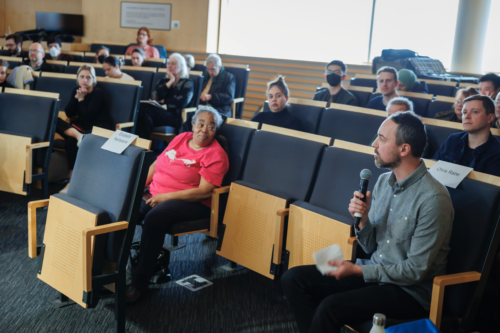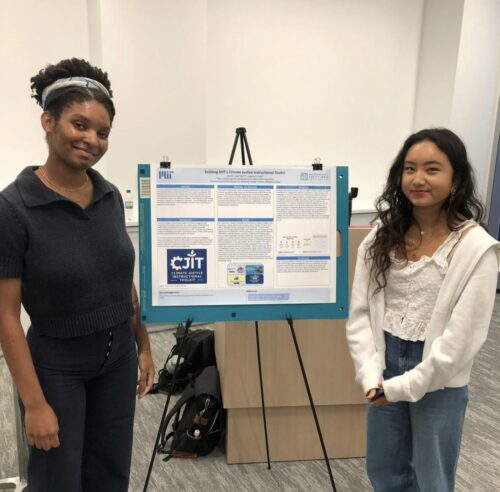Menu
ESI Stories
The ESI Launches the Climate Justice Instructional Toolkit
By: Sophia Apteker, Administrative and Communications Assistant
Even though the demand for climate solutions is ever-pressing and ever-present, research has shown that there is a lack of climate justice education in STEM fields. And how can scientists start developing solutions to a problem that they’re not even informed of?
Enter: the ESI’s Climate Justice Instructional Toolkit, a collection of resources for students and educators that gets climate conversations rolling in bite-sized, easily adaptable modules.
The Toolkit aligns with Fast Forward: MIT’s Plan for the Decade, published in the spring of 2021, that acknowledged MIT’s need to bolster its climate education offerings and committed itself to net-zero carbon emissions by 2050. More specifically, the Toolkit reinforces the section of the plan titled The Imperative of Justice that noted that to achieve those goals, “it must do so fairly.”
That means understanding that low-income and BIPOC communities have been disproportionately affected by climate change, even though they are the least responsible for it. Furthermore, the plan states that, “the world will not solve the climate problem without solving the intertwined problems of equity and economic transition.” These kinds of topics, the ones that directly address the inequitable causes and impacts of climate change, are foundational to the Toolkit.
Toolkit contents
The Toolkit consists of a a starter guide for teaching climate and environmental justice, resources for students, climate justice data sets, and 12 adaptable teaching modules. There will also be a Teaching Climate Justice Across the Curriculum workshop series during the 2023-2024 academic year.
The modules, which are foundational and discipline-specific, include:
Foundational Climate and Environmental Justice Modules
- Introduction to Climate Justice
- Climate Justice Policy
- Global Climate Justice
- The Just Transition
- Indigenous Climate Action
- Mapping Environmental Justice
- Mining and Climate Justice Case Studies
- The Emotions of Climate Justice
- Energy Justice
Discipline-Specific Modules
- Engineering Climate Justice
- Climate Justice in Biology, Exposure Science, and Epidemiology
- Climate Justice for Inclusive STEM Research and Communication
Accompanying instructor guides can be found here.
In each module, there are learning objectives and an agenda, foundational resources (like videos or readings), lecture material and notes, and project and assignment options.
The ESI is looking to expand into more discipline-specific modules in the future.
For student and educator use
The Toolkit is intended to be integrated into undergraduate introductory courses, specifically in disciplines related to sustainability and environmental education. But they don’t have to be plugged verbatim. Instead, they can be adapted to fit certain subject areas.
For example, Nuclear Science and Engineering Professor Haruko Wainwright, who worked with ESI postdoctoral associate Chris Rabe to review and pilot the Engineering Climate Justice module, will use various materials from that resource in a new lecture this semester that centers climate justice as a guiding principle for engineering. In addition, Basuhi Ravi, a PhD candidate in Materials Science and Engineering, used slides from the Introduction to Climate Justice module while teaching an experiential sustainability course this past summer. Both of these instructors reviewed the modules and selected relevant slides and resources that met the needs of their specific teaching contexts.

Chris Rabe (ESI postdoctoral associate) responds to a question from Bettina Stoetzer (MIT Associate Professor of Anthropology) during the Climate Justice Launch event in April. Photo credit: Tim Correira
The Toolkit’s flexibility also lends itself to be given to collegiate students as a resource to self-study, to be adapted for high school students, or to be used for the professional development of staff and administrators. At the very least, the Toolkit can be used to spark discussions, to plant a seed.
Toolkit builders
The Toolkit was funded by the Alumni Class Funds Grant and crafted by a six-person team of students and ESI staff who have been working on the project since June 2023.
Several of these students were part of the ESI’s Rapid Response Group (RRG), which aims to respond to critical environmental issues in a timely manner with science-based analysis and assistance in the service of their partners in communities, civil society, government, and industry. Since the Toolkit’s resources were co-constructed with students, who are the Toolkit’s primary audience, the ESI was able to integrate valuable undergraduate perspectives into its lessons and activities.
Toolkit builders include: Chris Rabe (ESI postdoctoral associate), Madison York (Northeastern University co-op student), Rachel Carethers (Wellesley College RRG student), Amberley Yang (Wellesley College RRG student), Bethany Costanzo (Northeastern University UROP student), and Sylvia Scharf (ESI climate education specialist).

RRG students Rachel Carethers and Amberly Yang presented their research at the RRG showcase at the MIT Museum in September. Photo credit: Sophia Apteker
“There is a pressing need to integrate the voices, knowledge, and experiences of those most impacted by climate change into the curriculum,” said Rabe. “The goal of the Climate Justice Instructional Toolkit is to spur more cross-disciplinary climate justice teaching and learning by providing resources, examples, and instructional guidance to a general audience.”
Have you explored or used our climate justice resources? Fill out this form or contact Chris Rabe at cjrabe@mit.edu to tell us more about your experience.















